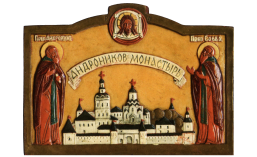
РАСПИСАНИЕ
https://andronikov-monastery.moscow
Понедельник 3 марта 2025 года
Седмица 1-я Великого поста
Свт. Льва, папы Римского
7.00 Утреня. Часы Изобразительны. Вечерня
Спасский собор
все духовенство
(византийское пение)
18.00 Великое повечерие
Великий покаянный канон
прп. Андрея Критского
Служба будет совершаться
параллельно в двух храмах:
в Спасском соборе
архим. Дионисий
(византийское пение)
и в храме св. Димитрия Донского
прот. Вячеслав
(знаменный распев)
Вторник 4 марта 2025 года
Апп. от 70-ти Архиппа и Филимона
и мц. равноап. Апфии
7.00 Утреня. Часы Изобразительны. Вечерня
Спасский собор
прот. Анатолий
(византийское пение)
18.00 Великое повечерие
Великий покаянный канон
прп. Андрея Критского
Служба будет совершаться параллельно в двух храмах:
в Спасском соборе
архим. Дионисий
(многоголосное пение)
и в храме св. Димитрия Донского
прот. Вячеслав
(знаменный распев)
Среда 5 марта 2025 года
Прп. Льва, еп. Катанского
7.00 Утреня. Часы Изобразительны. Вечерня
Литургия Преждеосвященных Даров
Спасский собор
все духовенство
(византийское пение)
18.00 Великое повечерие
Великий покаянный канон
прп. Андрея Критского
Служба будет совершаться параллельно в двух храмах:
в Спасском соборе
архим. Дионисий
(многоголосное пение)
и в храме св. Димитрия Донского
иерей Анатолий
(знаменный распев)
Четверг 6 марта 2025 года
18.00 Великое повечерие
Великий покаянный канон
прп. Андрея Критского
Служба будет совершаться в Спасском соборе
иерей Анатолий
(византийское пение)
Пятница 7 марта 2025 года
Обретение мощей мучеников, иже во Евгении
7.00 Утреня. Часы. Изобразительны.
Вечерня. Литургия Преждеосвященных Даров
Благословение колива
Спасский собор
все духовенство
(многоголосное пение)
17.00 Утреня
Спасский собор
иерей Анатолий
(знаменный распев)
Суббота 8 марта 2025 года
Вмч. Феодора Тирона
8.00 Литургия
архим. Дионисий
иерей Анатолий
(многоголосное пение)
17.00 ВСЕНОЩНОЕ БДЕНИЕ
Спасский собор
все духовенство
(многоголосное пение)
Воскресенье 9 марта 2025 года
Неделя 1-я Великого поста
Торжество Православия
Первое и второе обретение
главы Иоанна Предтечи
7.00 Ранняя Литургия
Литургия свт. Василия Великого
Спасский собор
иерей Анатолий
(византийское пение)
9.00 Поздняя Литургия
Литургия свт. Василия Великого
Молебное пение
Недели Православия
Спасский собор
архим. Дионисий
(многоголосное пение)
9.00 Поздняя Литургия
Литургия свт. Василия Великого
Молебное пение
Недели Православия
храм св. Димитрия Донского
прот. Вячеслав
(знаменный распев)
